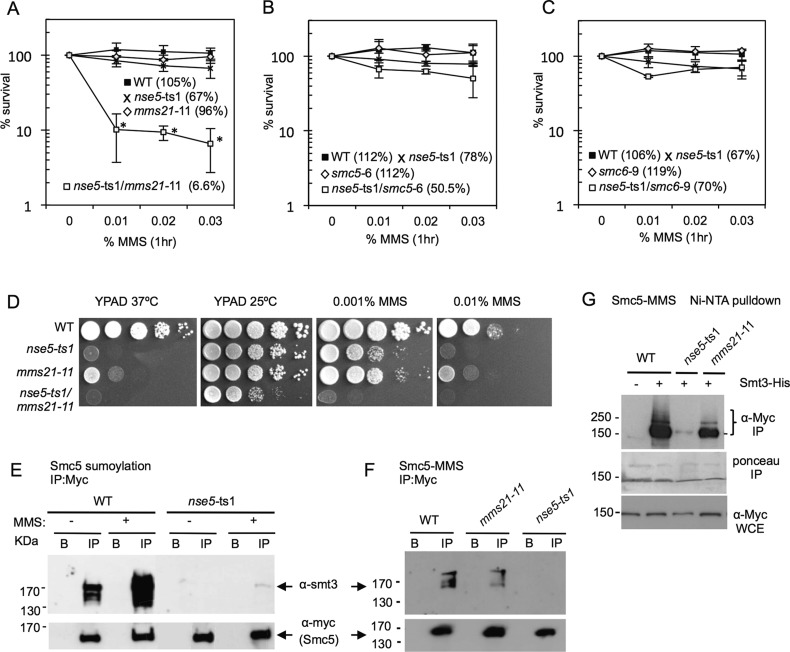Fig. 1.
Genetic interactions and Smc5 sumoylation with the nse5-ts1 mutant allele of the Smc5/6 complex. (A-C) Cell viability was monitored as colony outgrowth from asynchronous cultures after transient exposure to MMS at indicated concentrations for 1 h at 30°C, with values normalized to survival at time point 0. The % survival reported in graph is value after treatment with 0.03% MMS. Data points represent the mean±s.d. at each concentration of MMS from n=3 experiments performed in technical duplicate. *P<0.01 compared to wild-type cells with values from a two-tailed t-test. Drop assays on YPAD at 37°C or 25°C without or with the indicted amounts of MMS were performed on 1:10 serial dilutions of exponentially growing cultures. The following strains were used: wild-type (WT) (JC471), nse5-ts1 (JC1321), smc5-6 (JC1844), nse5-ts1/smc5-6 (JC1843), smc6-9 (JC1358) and nse5-ts1/smc6-9 (JC1359), mms21-11 (JC1981) and nse5-ts1/mms21-11 (JC1319). (D) Drop assays (1:10 serial dilutions) from exponentially growing cultures were performed on YPAD medium at 37°C or 25°C without or with MMS at the indicated concentration for wild-type (JC1157), nse5-ts1 (JC1321), mms21-11 (JC1981) and nse5-ts1/mms21-11 (JC1319). (E,F) Smc5 sumoylation was analyzed in cells without or with 0.3% MMS at 25°C by immunoprecipitation of Myc-Smc5 followed by western blot analysis with anti-Smt3 at a concentration of 1:3000 (a kind gift from Zhao lab). Blots were then stripped and re-probed using anti-Myc antibody (9E10) at a concentration of 1:1000 to confirm equal loading. In a side-by-side comparison, Smc5 sumoylation increases upon MMS treatment and is reduced in nse5-ts1 cells (JC911) and mms21-11 (JC954) compared to wild-type (JC720). (G) As an alternative method to detect sumoylation, proteins were isolated by Ni-NTA affinity purification of His-Smt3 as described previously at 25°C (Wohlschlegel et al., 2004; Psakhye and Jentsch, 2012; Bustard et al., 2012) followed by western blotting with anti-Myc antibodies to visualize sumoylated proteins in cells containing Myc-tagged Smc5 with un-tagged Smt3 wild-type (JC720), or His8-tagged Smt3 in wild-type (JC1157), nse5-ts1 (JC1156) and mms21-11 (JC1155) after treatment with 0.3% MMS.

